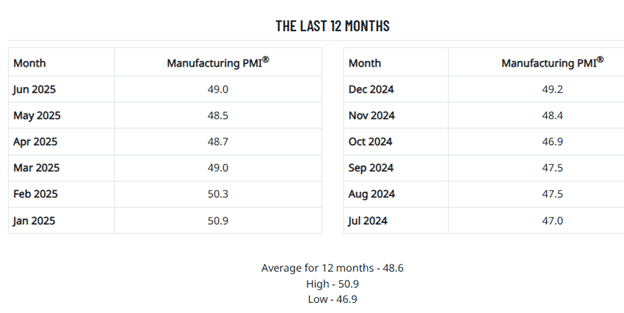The US Purchasing Managers Index (PMI) for June was released Tuesday by the Institute for Supply Management (ISM), and came in at a level of 49.0, a little up from 48.5 in May, but falling below the key 50 mark that separates US manufacturing expansion from contraction for 30 out of the last 32 months.
Supply Chain Digest Says... |
 |
|
| Another manager in the computers and electrics sector stated that: “Tariffs continue to cause confusion and uncertainty for long-term procurement decisions. The situation remains too volatile to firmly put such plans into place.“ |
|
 |
|
What do you say? |
|
| Click here to send us your comments |
|
| |
|
| Click here to see reader feedback |
|
|
|
Those two months of manufacturing expansion in January and February came after along 26-month stretch of contraction – and now succeeded by four more months below 50.
However, ISM says that the overall economy continued in expansion for the 62nd consecutive month after one month of contraction in April 2020. The PMI itself tracks closely but not exactly with the overall US economy.
A Manufacturing PMI above 42.3, over a period of time, generally indicates an expansion of the overall economy, according to ISM.
The other PMI numbers we track were mostly negative.
The New Orders Index was again in contraction territory, registering 46.4, below 50 for the fifth month in a row following a three-month period of expansion. That was also 1.2 percentage points lower than the 47.6 recorded in May, in bad news for future US manufacturing activity.
However, the June reading of the Production Index (50.3) is 4.9 percentage points higher than May’s figure of 45.4, returning the index to expansion territory.
The Prices Index remained in expansion (or increasing) territory, registering 69.7, up 0.3 percentage point compared to the reading of 69.4 reported in May (above 50 = rising prices), so prices rose again but at a somewhat smaller rate).
The Backlog of Orders Index registered 44.3, down 2.8 percentage points compared to the 47.1 recorded in May. meaning order books are declining on average.
The Supplier Deliveries Index indicated slower delivery performance, though the pace picked up somewhat: The reading of 54.2 is down 1.9 percentage points from the 56.1 recorded in May.
Supplier Deliveries is the only ISM index that is inversed, with a reading of above 50 indicating slower deliveries, which is typical as the economy improves and customer demand increases - or the reverse.
The Inventories Index registered 49.2, up 2.5 percentage points compared to May’s reading of 46.7, meaning companies in total decreased inventory in the month, but at a slower pace.
Said Susan Spence, Chair of the Institute for Supply Management, Manufacturing Business Survey Committee, stated that: “The demand indicators remain mixed, with the New Orders and Backlog of Orders indexes contracting at faster rates, while the Customers’ Inventories and New Export Orders indexes contracted at slower rates. A ‘too low’ status for the Customers’ Inventories Index is usually considered positive for future production.”
(See More Below)
|
CATEGORY SPONSOR: SOFTEON |
|
|
|
|
|
As always, the ISM report provides a graphic of the PMI scores for the last 12 months, which as can be seen show the two months over 50 in January and February after a long stretch of contraction since November 2022. It is now averaging just 48.6 over the past year.

Source: ISM
However, of the 18 sectors tracked by ISM, 9 reported growth in June. Listed in order of most growth, they are Apparel, Leather & Allied Products; Petroleum & Coal Products; Nonmetallic Mineral Products; Miscellaneous Manufacturing; Furniture & Related Products; Computer & Electronic Products; Machinery; Food, Beverage & Tobacco Products; and Electrical Equipment, Appliances & Components
As always, there were some interesting comments from PMI survey respondents.
“Business has notably slowed in last four to six weeks. Customers do not want to make commitments in the wake of massive tariff uncertainty.” said one manager in the fabricated metal products sector.
Another manager in the computers and electrics sector stated that: “Tariffs continue to cause confusion and uncertainty for long-term procurement decisions. The situation remains too volatile to firmly put such plans into place.“
.
Finally, a manager in the transportation equipment sector stated that “The word that best describes the current market outlook is ‘uncertainty.’ The erratic trade policy with on-again/off-again tariffs has led to price uncertainty for customers, who appear to be prepared to hold off large capital purchases until stability returns. This has resulted in further reductions in customer demand and softening sales for the balance of 2025."
What are your thoughts on this ISM PMI? Let us know your thoughts at the Feedback section below.
Your Comments/Feedback
|

